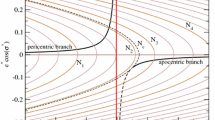Abstract
If a dynamical problem ofN degress of freedom is reduced to the Ideal Resonance Problem, the Hamiltonian takes the form
Herey is the momentum-vectory k withk=1,2−N, x 1 is thecritical argument, andx k fork>1 are theignorable co-ordinates, which have been eliminated from the Hamiltonian.
The purpose of this Note is to summarize the first-order solution of the problem defined by (1) as described in a sequence of five recent papers by the author. A basic is the resonance parameter α, defined by
The solution isglobal in the sense that it is valid for all values of α2 in the range
which embrances thelibration and thecirculation regimes of the co-ordinatex 1, associated with α2 < 1 and α2 > 1, respectively. The solution includes asymptotically the limit α2 → ∞, which corresponds to theclassical solution of the problem, expanded in powers of ε ≡ μ2, and carrying α as a divisor. The classical singularity at α=0, corresponding to an exact commensurability of two frequencies of the motion, has been removed from the global solution by means of the Bohlin expansion in powers of μ = ε1/2. The singularities that commonly arise within the libration region α2 < 1 and on the separatrix α2 = 1 of the phase-plane have been suppressed by means of aregularizing function
introduced into the new Hamiltonian.
The global solution is subject to thenormality condition, which boundsAB″ away from zero indeep resonance, α2 < 1/μ, where the classical solution fails, and which boundsB′ away from zero inshallow resonance, α2 > 1/μ, where the classical solution is valid. Thedemarcation point
conventionally separates the deep and the shallow resonance regions.
The solution appears in parametric form
It involves the standard elliptic integralsu andE((u) of the first and the second kinds, respectively, the Jacobian elliptic functionssn, cn, dn, am, and the Zeta functionZ (u).
Similar content being viewed by others
References
Aoki, S.: 1963,Astron. J. 68, 385.
Garfinkel, B.: 1960,Astron. J. 65, 624.
Garfinkel, B.: 1966,Astron. J. 71, 657 (Paper I).
Garfinkel, B.: 1972a,Celes. Mech. 5, 189 (Paper III).
Garfinkel, B.: 1972b,Celes. Mech. 5, 451 (Paper IV).
Garfinkel, B.: 1972c,Celes Mech. 6, 151 (Paper V).
Garfinkel, B.: 1973,Celes. Mech. 7, 205 (Paper VI).
Garfinkel, B., Jupp, A. H., and Williams, C. A.: 1971,Astron. J. 76, 157 (Paper II).
Hagihara, Y.: 1961,S.A.O. 5, 39.
Hori, G.: 1960,Astron. J. 65, 291.
Author information
Authors and Affiliations
Rights and permissions
About this article
Cite this article
Garfinkel, B. Global solution of the ideal resonance problem. Celestial Mechanics 8, 207–212 (1973). https://doi.org/10.1007/BF01231415
Issue Date:
DOI: https://doi.org/10.1007/BF01231415




